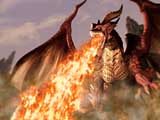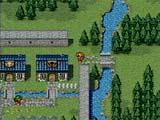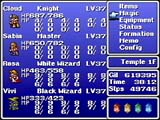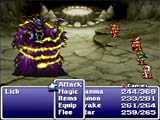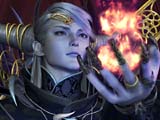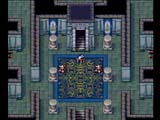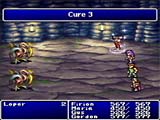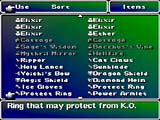
| Platform: PlayStation | Publisher: Square EA LLC |
| Genre: Turn-Based RPG | Developer: Square Soft | Format: CD-ROM | Expected Release: April 2003 |
On the first day, Baer created the Brown Box and it was good.
In 1987, Square Soft released Final Fantasy for the Nintendo Famicom console and was brought over onto the NES shortly after. Final Fantasy was meant to be Hironobu Sakaguchi's last game, yet it would not be his swan song but the beginning of a legacy. Final Fantasy was what originally launched console RPGs into greatness among gamers, although the genre had yet to truly penetrate into the American mainstream market. RPG fans would have to wait until Final Fantasy VII for the genre to truly take a firm foothold in the US. Sadly, when Square Soft released Final Fantasy II and III for the Famicom, they deemed them inappropriate for the US audience and were never localized. Just a few years ago, Square Soft would go on to re-release FF I & II (with a significant visual upgrade) in Japan for Bandai’s ill-fated handheld, the WonderSwan Color. This Spring, after more than a decade of waiting, Square Soft will be bringing Final Fantasy and Final Fantasy II to America for the PlayStation in a collection called Final Fantasy Origins. RPGFan recently had a chance to spend some time with Squaresoft's refurbished classics and from what we’ve seen; the old-school has shaped up quite well.
Final Fantasy I & II were originally released in the 1980s as 8-bit games which doesn’t bode well for their graphics. For the Final Fantasy Origins collection, Square Soft did a 16-bit redraw and the sprite-based characters and backgrounds are now on par with Final Fantasy IV for the Super Famicom. Final Fantasy’s combat visuals have also been redone as well; resembling the battle sequences from the SNES games instead of the original "in a box" view. In addition to the facelift, both games have received CG intros which are simply stunning. Although the original Final Fantasy lacked plot depth, its opening cinema is one of Squaresoft's best. Final Fantasy II’s introduction involves a brilliantly rendered chase scene out of a city, and is just as impressive as the intro to Final Fantasy. Eye-candy aside, Square Soft is not gambling on the graphics to sell this collection, however, as the meat of the game is in the gameplay and nostalgia.
Final Fantasy’s story is as simple as they come: save the world. There’s not much in the way of NPC interaction or character development. You just happen to be the Light Warriors: protectors of the weak and down-trodden. Sucks for you, eh? Don’t expect the villagers, or any other characters for that matter, to care in the least for any of your party. Final Fantasy II's plot, however, is more of what we’d come to expect from Square Soft. The tale begins in the city of Fynn during an Imperial invasion. The thief Firion, the mage Maria, the monk Gus and fighter Leon manage to escape from the demonic troops of the Empire. Fynn buckles under the Empire’s force as the youths watch their homes and their families burn to ashes in the night. Still on the run from the overwhelming horde of seemingly indestructible troops, Firion and company fall in battle, yet all is not lost. Their dying bodies are found and revived, but Leon is missing. With new resolve, the orphaned fugitives join forces with the rebels led by Princess Hilda in hopes of finding their lost companion, exacting justice from the Empire and saving the world in the process. Final Fantasy Origins doesn’t tout the best or most intricate plots in existence, but considering these are stories from decade old games, they shouldn’t be compared to modern-day epics.
Although Final Fantasy and Final Fantasy II were released close together, they have two completely different gameplay systems. Final Fantasy allows the player to create a party of 4 Light Warriors at the beginning of the game out of a possible 6 class types: fighter, white mage, red mage, black mage, thief and monk. Players increase the levels of the Light Warriors from experience earned by killing monsters; pretty standard stuff. Skills and spells, however, must be bought from shops and are class-specific. Final Fantasy II’s system is quite unique as there are no experience points involved. When a character uses an action frequently, they become more skilled in that ability, but become less skilled in others. If a player character uses physical attacks, their blows will become stronger but their skills in magic will dwindle. Likewise, if a character takes a lot of damage, their maximum hit points increase. Luckily, Square has tweaked the difficulty for Final Fantasy II so players shouldn’t feel forced to have the party fight themselves to level up their hit points. The system takes a while to get used to and many will miss having a standard EXP point system.
The music and sound effects in both games suffice and are an improvement over the original PCM tunes, but they are not the stellar soundtracks the current Final Fantasy games enjoy. Though it is impressive to see just how far Nobuo Uematsu’s composing has come since these first releases. The soundtrack to Final Fantasy Origins is not bad by any means, but is beginning to show its age. This is certainly not an OST that gamers will be scampering to online stores to pick up ASAP.
Final Fantasy was the beginning of an empire and Final Fantasy II heralded the development of a plotline. Gamers weaned on Final Fantasy VII-X may find it hard to grasp the outdated graphics and now-cliché gameplay, but those who can remember playing with the Light Warriors on the NES or even Cecil and co. on the SNES will appreciate Square’s newest compilation. Luckily, load times have been kept to a minimum in both games, and gamers can expect a smooth experience. Final Fantasy Origins is set for a US release this Spring.
Final Fantasy was the title that started it all for Square Soft, and now the original game and its first sequel are both getting a make-over for their PlayStation debut. The graphics in both games have been given a total overhaul with upgraded visuals on par with their SNES offspring. Square has even included entirely new CG movies in both tales to help push their stories along. It is unknown if Square will resample Nobuo Uematsu’s original scores to take advantage of the PlayStation’s architecture, but some acoustic upgrade is expected. Unfortunately, both games will be released separately, unlike the previous anthologies.
The original “Final Fantasy” had a plot about as simple as could be: the elements of Water, Earth, Wind and Fire are out of balance and the world is on the brink of total chaos. Four brave adventurers, the Light Warriors, must venture forth to unravel the mystery behind the current strife and restore order to the world. There isn’t much in the way of story, but at the time the game was originally released this was one of the largest, deepest and most difficult adventures around. Players can choose their four heroes from several now-classic classes including red, white and black mages, fighters, black belts and thieves. At a certain point in the game, their abilities are permanently increased by the dragon lord Bahamut, changing mages to wizards, fighters to knights, black belts to grand masters and thieves to ninja. Final Fantasy uses a turn-based combat system with spells being bought rather than learned, just like weapons and armor.
Final Fantasy II never saw release in North America, but it introduced the elements that have become the hallmark of the series since: a complex storyline and well-developed characters. Unlike the anonymous do-gooders of the first game, the characters in this installment have personal histories, motivations and personalities, rudimentary as they were. The sequel is the story of an evil empire (the first of many!) and its plans to take over the world. Players will take control of Frioniel, Maria, Guy and Lionheart: four refugees from a conquered kingdom, as they band together to overthrow the empire and its wicked ruler. Their quest for justice will lead them to uncover a more twisted scheme beneath the surface, a template that all the games in the series so far have followed. Final Fantasy II is also the first game to feature the endlessly-reincarnated machinist, Cid.
Final Fantasy II’s combat system is much like the original, but the straightforward experience system has been left behind in favor of one more skill-based. As characters use abilities, they become more proficient in them instead of leveling up directly. Using a sword, for example, will make a character’s strength increase along with his weapon skill; the same holds true for other actions. However this system is a double edged blade. If a character performs actions or use abilities in opposition to the ones they are adept at, their proficiency in their previously favored techniques will decrease.
While Final Fantasy and Final Fantasy II may not be as advanced or enticing as the previous PlayStation re-releases of their successors, these two titles will provide many gamers the chance to see where it all began. Both titles are slated to be released in Japan at the end of October. Sadly, neither game has been announced for a domestic release. ©1987,1988,2000,2001,2002 SQUARE CO., LTD. All Rights Reserved. Illustration © 1987, 1988 Yoshitaka Amano |



